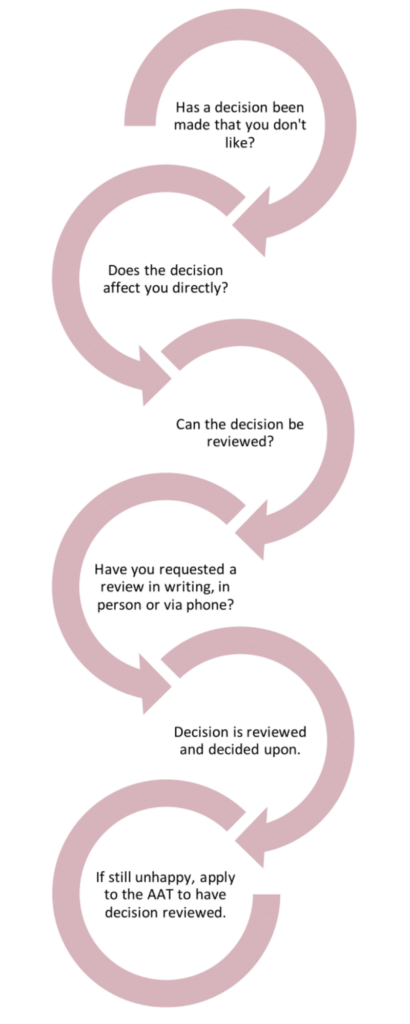
My NDIS plan sucks! What can I do?
In recent times, we have noticed an increase in participants having less than desirable outcomes for the NDIS plan reviews. Because of this, we thought we might put a few tips together to help you mitigate your circumstances. So, if you believe a decision about your plan is incorrect or unfair there is a course of action you can take. This is called a ‘review process’ and we have unpacked it a little bit for you in the below blog.
Review of decisions
The NDIA has a number of significant decision making powers. There is a list below that sets out all of the ‘reviewable decisions’. If you would like a decision to be reviewed, the NDIA does not provide any legal assistance to you. It is important however to note that there is no fee for requesting a review. The stages of review are:
Internal review
The first stage of review for decisions is a process which is called an ‘internal merits review’. This means an internal review undertaken by an authorised person in the NDIA who was not involved in the original decision.
Before this internal review, the Agency will encourage you to request reconsideration by the original decision-maker about your concerns, particularly when you believe that an important matter has been overlooked or new information is now available.
Notice of review
The NDIA must provide written notice of a reviewable decision to each person directly affected by the decision. A person directly affected by the decision has three months from the time they received the notice to request a review of the decision.
Power of reviewer
A decision reviewer may:
• Confirm
• Vary
• Or set aside the original decision.
A request for review of a decision does not affect the operation of the decision or prevent actions being taken to implement the decision. The original decision still operates until it is changed.
External review
A person may apply to the Administrative Appeals Tribunal (AAT) for an external review of the decision to:
• Confirm
• Vary
• Or set aside the original decision arising from the internal review process
This application must be made within 28 days after you received the appeal decision from the NDIA. The AAT can extend this time if they believe it is reasonable to do so.
The AAT is not a court and attempts to resolve matters speedily through mutual agreement.
The review process generally consists of the following steps:
• You will be contacted by a ‘Contact Officer’, who will discuss your application with you, usually within three days of the Tribunal receiving your application.
• The Tribunal will then tell the NDIA they have received your application. The NDIA will then send both you and the Tribunal a copy of all the documents you have that are relevant to your application.
• In most cases, the Tribunal will then arrange a case conference – an informal meeting which discusses whether the case can be resolved by agreement.
• If there is no agreement at the case conference, the Tribunal will create a case plan. The first step will be a formal conciliation, where the AAT will work with both you and the Agency to reach an agreement and resolve the case.
• Only then will the AAT hold a hearing and make a decision. If you want a decision quickly, you can request it at the case conference, and the tribunal will not hold a conciliation session.
Reviewable decisions
The following is a list of some of the decisions that the NDIA can make that may be reviewed:
• A decision that a person does not meet the access criteria
• A decision not to specify a period longer than 28 days for a prospective participant to comply with a request
• A decision to revoke a person’s status as a participant
• A decision to approve the statement of participant supports in a participant’s plan
• A decision not to extend a grace period
• A decision not to review a participants plan
• A decision to approve a person or entity as a registered provider of supports
• A decision to revoke an approval as a registered provider of supports
• A decision to make, or not to make, a determination about who may do things on behalf of a child for the purposes of the Act
• A decision to make, or not to make, a determination that a person has a parental responsibility for a child
• A decision to appoint a plan nominee
• A decision to appoint a correspondence nominee
• A decision to cancel or suspend, or not to cancel or suspend, the appointment of a plan nominee
• A decision to give a notice to require a person to take reasonable action to claim or obtain compensation
• A decision to give a notice that NDIA proposes to recover an amount specified in the notice from an amount of compensation
• A decision not to treat the whole or part of a compensation payment as not having been fixed by a judgement or settlement.
The following flow chart details the stages in the review of a decision

Important Reference:
The information within this blog has been extracted from the Discover Guide, a comprehensive guide to the NDIS prepared by La Trobe University and funded by the National Disability Insurance Agency. The guide aims to help people understand the various parts of the NDIS and how to access them.
Casey, G., Keyzer, P., & O’Donovan, D. (2016) Discover (2nded.). Melbourne: La Trobe University.
